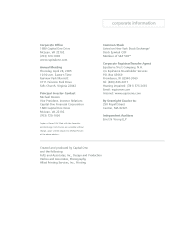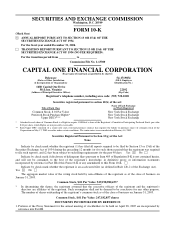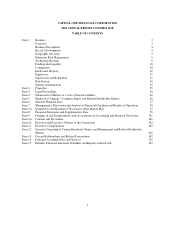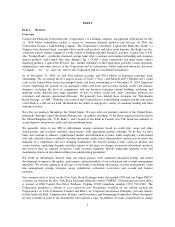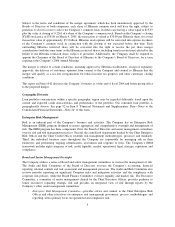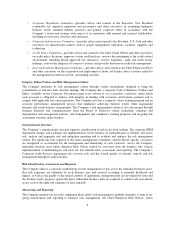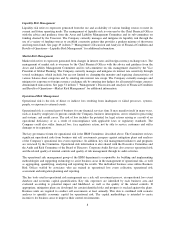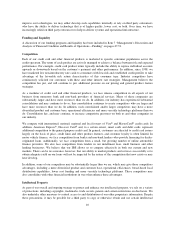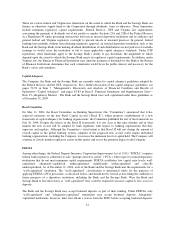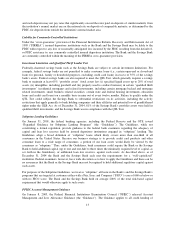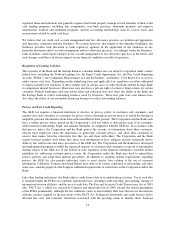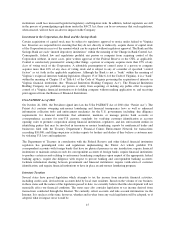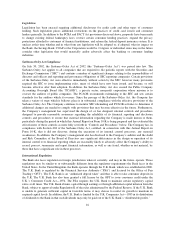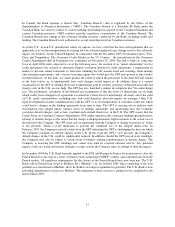Capital One 2004 Annual Report Download - page 31
Download and view the complete annual report
Please find page 31 of the 2004 Capital One annual report below. You can navigate through the pages in the report by either clicking on the pages listed below, or by using the keyword search tool below to find specific information within the annual report.Liquidity Risk Management
Liquidity risk refers to exposures generated from the use and availability of various funding sources to meet its
current and future operating needs. The management of liquidity risk is overseen by the Chief Financial Officer
with the advice and guidance from the Asset and Liability Management Committee and its sub-committee on
funding chaired by the Treasurer. The Company currently manages and mitigates its liquidity risk through the
use of a variety of funding sources to establish a maturity pattern that provides a prudent mixture of short-term
and long-term funds. See page 49 in Item 7 “Management’s Discussion and Analysis of Financial Condition and
Results of Operations—Liquidity Risk Management” for additional information.
Market Risk Management
Market risk refers to exposures generated from changes in interest rates and foreign currency exchange rates. The
management of market risk is overseen by the Chief Financial Officer with the advice and guidance from the
Asset and Liability Management Committee and its sub-committee on risk management chaired by the Vice
President of Global Planning. The Company currently manages and mitigates its interest rate sensitivity through
several techniques, which include, but are not limited to, changing the maturity and repricing characteristics of
various balance sheet categories and by entering into interest rate swaps. The Company currently manages and
mitigates its exposure to foreign currency exchange risk by entering into hedges for all material foreign currency
denominated transactions. See page 51 in Item 7 “Management’s Discussion and Analysis of Financial Condition
and Results of Operations—Market Risk Management” for additional information.
Operational Risk Management
Operational risk is the risk of direct or indirect loss resulting from inadequate or failed processes, systems,
people, or exposure to external events.
Operational risk is a normal part of business for any financial services firm. It may manifest itself in many ways,
such as fraud by employees or persons outside the Company, business interruptions, errors related to processing
and systems, and model errors. The risk of loss includes the potential for legal actions arising as a result of an
operational deficiency or as a result of noncompliance with applicable laws or regulatory standards. The
Company could also suffer financial loss, face regulatory action, not be able to service customers and suffer
damages to its reputation.
The key governance forum for operational risk is the ERM Committee, described above. The Committee reviews
significant operational risks from business unit self assessments, progress against mitigation plans and analyses
of the Company’s operational loss event experience. In addition, key risk management initiatives and programs
are reviewed by the Committee. Operational risk information is also shared with the Executive Committee and
the Audit and Risk Committee of the Board of Directors. Corporate Audit Services also assesses operational risk
and the related quality of internal controls and quality of risk management through its audit activities.
The operational risk management group of the ERM department is responsible for building and implementing
methodologies and supporting technology to assist business areas in the management of operational risk, as well
as aggregating, quantifying, analyzing and reporting the results. The individual business areas utilize Business
Risk Offices staffed by associates who are trained in operational loss event collection, operational risk
assessment and mitigation planning and reporting.
The key tools used in operational risk management are a risk self assessment process, an operational loss event
database and economic capital quantification. Key risk exposures are identified by each business area and
evaluated according to potential impact and likelihood, as well as the quality of the related controls. If
appropriate, mitigation plans are developed for certain identified risks and progress is tracked against the plans.
Business units are required to conduct self assessments at least annually. This data is combined with scenario
analyses to quantify economic capital for operational risk. The capital methodology is intended to create
incentives for business areas to improve their control environments.
8



